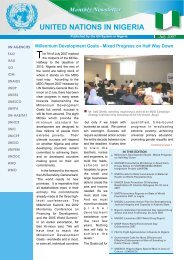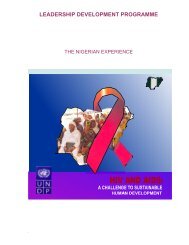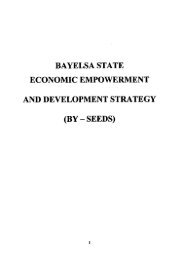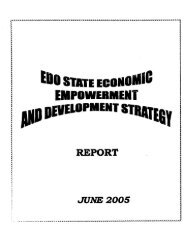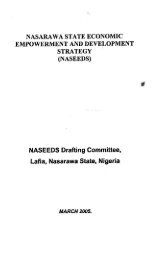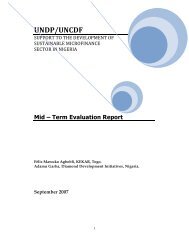Niger Delta Human Development Report - UNDP Nigeria - United ...
Niger Delta Human Development Report - UNDP Nigeria - United ...
Niger Delta Human Development Report - UNDP Nigeria - United ...
Create successful ePaper yourself
Turn your PDF publications into a flip-book with our unique Google optimized e-Paper software.
There is a paucity of<br />
data at the local<br />
government level,<br />
including information<br />
on fiscal operations.<br />
The GDI for the <strong>Niger</strong> <strong>Delta</strong> Region<br />
While the HDI measures average<br />
achievement, the GDI adjusts this average<br />
achievement to reflect the inequalities<br />
between men and women. For the <strong>Niger</strong><br />
<strong>Delta</strong> states, the average GDI for 2005<br />
was 0.444, compared to 0.439 for <strong>Niger</strong>ia<br />
(see table 2.13). This indicates that the<br />
<strong>Niger</strong> <strong>Delta</strong> states have outperformed the<br />
national average, although such states as<br />
Abia, <strong>Delta</strong> and Imo have performed<br />
below the average. The delta region has<br />
done comparatively well with respect to<br />
gender equality in education, as measured<br />
by the equally distributed educational index,<br />
and in terms of life expectancy. The states<br />
have done badly, however, on gender<br />
equality and income, particularly Akwa<br />
Ibom, <strong>Delta</strong> and Imo states.<br />
The delta’s GDI score fares poorly in<br />
comparison with the scores of other oilproducing<br />
countries. In 2003, Oman scored<br />
0.759, Venezuela 0.765, Saudi Arabia 0.749<br />
and Indonesia 0.691 (<strong>UNDP</strong>, 2005).<br />
Gender equality in the <strong>Niger</strong> <strong>Delta</strong> still<br />
clearly remains an important development<br />
challenge.<br />
Map 2.1: Administrative Map of the <strong>Niger</strong> <strong>Delta</strong> Region of <strong>Niger</strong>ia Showing Local Government Areas.<br />
The GEM for the <strong>Niger</strong> <strong>Delta</strong> Region<br />
The GEM measures that extent to which<br />
women are excluded from opportunities<br />
in a given country. The average GEM for<br />
the <strong>Niger</strong> <strong>Delta</strong> states is 0.399 (see table<br />
2.13). In the human development reports<br />
on <strong>Niger</strong>ia produced so far, the GEM<br />
could not be calculated because of data<br />
problems. This is the same case for many<br />
sub-Saharan countries.<br />
Compared with the lowest GEM performers<br />
in the world—Yemen (0.123), Saudi<br />
Arabia (0.207) and Iran (0.318)—the <strong>Niger</strong><br />
<strong>Delta</strong> is not doing too badly, but efforts<br />
need to be stepped up. While all the states<br />
performed very well on participation, the<br />
income index is quite low. In Imo, <strong>Delta</strong><br />
and Bayelsa states, women’s participation<br />
in parliamentary activities is very low relative<br />
to other states (see table 2.14).<br />
<strong>Human</strong> <strong>Development</strong> at the Local<br />
Level<br />
Map 2.1 contains the spatial distribution<br />
of local government areas in the region.<br />
Capturing spatial inequalities in human<br />
60 NIGER DELTA HUMAN DEVELOPMENT REPORT



